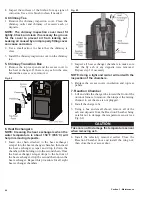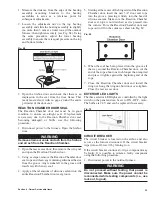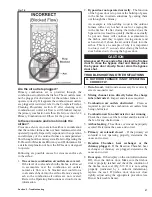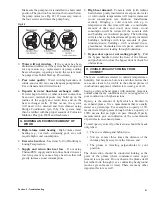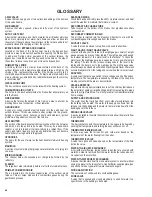
61
Section 5 - Troubleshooting
Make sure the pump motor is installed in a horizontal
position. The junction box must not be located below
the pump motor (see Fig. 82). If necessary, remove
the four screws and rotate the pump body.
Fig. 82
2. Water will not circulate - If the system has been
drained and refilled, or if the system has been opened
for any reason (e.g., replacement of pump, adding
heat exchangers, repairing a leak), the system must
be purged (see Initial Start-up Procedures).
3. Poor water quality - Water with high amounts of
solids, sand or dirt can cause frequent pump failure.
Use softened and/or filtered water.
4. Deposits in water lines/heat exchanger walls -
If water high in silica or other mineral content has
been used, material deposits may build up on the
insides of the supply and return lines and on the
heat exchanger walls. If this occurs, the system
will need to be drained and then cleaned using
Sludge Conditioner (p/n 166). The system must
then be refilled with the proper amount of Corrosion
Inhibitor Plus (p/n 1650) and fresh water.
G. BURNING AN EXCESSIVE AMOUNT OF
WOOD
1. High volume water heating - High volume water
heating (e.g., car wash, swimming pool, etc.) will
require high wood consumption.
2. Excessive heat loss - See items 6-10 of Building is
Losing Temperature.
3. Supply and return line heat loss - If not using
ThermoPEX, supply and return lines buried in a wet,
low-lying area may cause a large heat loss that will
greatly increase wood consumption.
4. High heat demand - Concrete slabs (with radiant
heat) that are poorly insulated or are exposed to water
or cold outside temperatures will require increased
wood consumption (see Hydronic Installations
section). Bringing a cold concrete slab up to
temperature the first time will take a considerable
amount of time and wood; once warm, wood
consumption will be reduced if the concrete slab
and building are insulated properly. The following
will also have a high heat demand: poorly insulated
buildings, buildings with large amounts of glass
windows/doors, buildings with overhead doors,
greenhouses, uninsulated crawl spaces, outdoor air
infiltration and air leaking through foundation.
5. Bypass door open or not sealing properly - Pull
the bypass handle toward the front of the furnace
and push down to close the bypass door or check for
obstructions.
H. VISIBLE EXHAUST COMING FROM
CHIMNEY
There are conditions related to outside temperatures,
humidity, fuel moisture, burn rate and other factors that
can cause steam to be visible in the exhaust plume of
combustion equipment, whether it is wood, gas or oil.
Seeing a white exhaust plume with moisture present is
normal under many conditions and is not suggestive of
poor combustion or high emissions.
Opacity is the amount of light which is blocked in
an exhaust plume. It is a measurement that is usually
stated as a percentage. For example, an opacity of 0%
means that all light passes through while an opacity of
100% means that no light can pass through. Opacity
measurements give an indication of the concentration
of particles in an exhaust plume.
To read opacity correctly, observations should be made
only when:
• The sun is shining and behind you,
• You are at least three times the distance of the
chimney height away from the furnace, and
• The plume is traveling perpendicular to your
position.
The observation should be conducted looking at the
point of the plume where condensed water vapor
(steam) is not present. Do not observe the plume itself
but rather look through it at a contrasting background
(such as green leaves or trees). There are many other
important factors as well.
Summary of Contents for e-Classic 1450 IR
Page 17: ...15 Section 1 Outdoor Furnace Installation...
Page 29: ...27 Section 1 Outdoor Furnace Installation Fig 30 Fig 31...
Page 30: ...28 Section 1 Outdoor Furnace Installation Fig 32 Fig 33...
Page 66: ...64 E CLASSIC 1450 WIRING DIAGRAM Section 6 General Information...
Page 67: ...65 Section 6 General Information E CLASSIC 1450 WIRING DIAGRAM OPTIONAL POWER IGNITION...
Page 69: ...67 NOTES...
Page 70: ...68 NOTES...
Page 71: ...69 NOTES...


